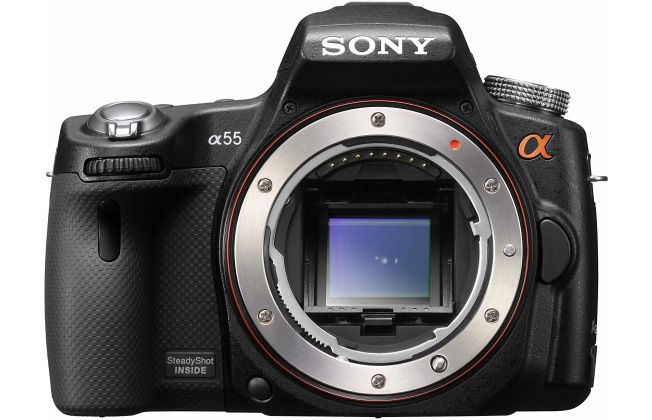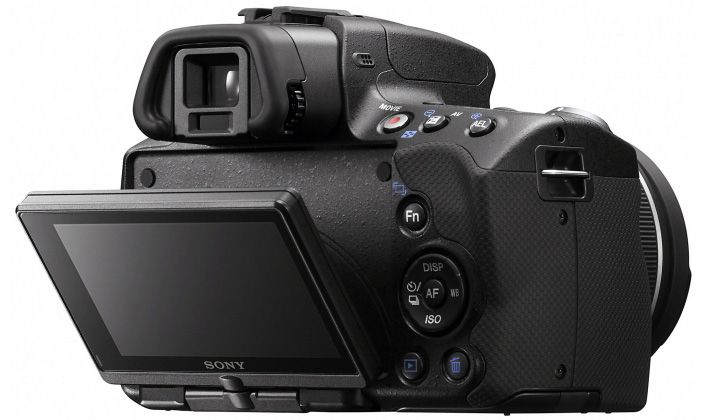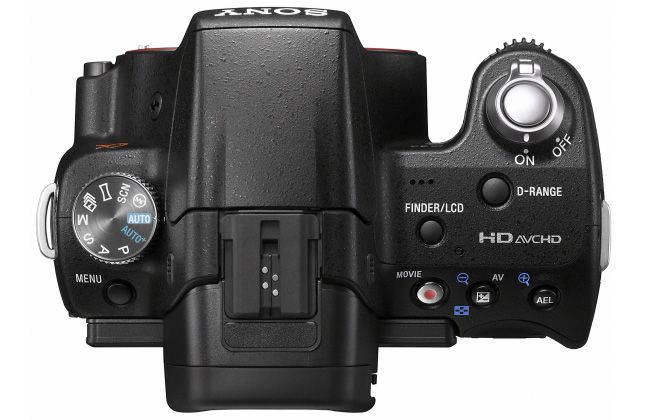The Sony Alpha SLT-A55 is an SLT (Single Lens Translucent) camera rather than a traditional DSLR. With this impressive new technology the A55 is capable of shooting 10 frames per second while continually focusing, can shoot 1080i HD video and even has GPS for geo-tagging your images. Is the tech-laden model as genius as it sounds?
Our quick take
Part of a new generation of cameras, the SLT-A55 is truly innovative. The 10fps continuous shooting is incredibly good and far outclasses the next nearest DSLR in this department, not to mention significantly by price.
Downsides are few and far between, and may be to a matter of taste rather than significant negatives: the main point is that the electronic viewfinder may not be for everyone, as it’s quite different to the feel of an optical version. However it does add some technological advances that will tick the box for a more tech-savvy audience.
All in all the combination of fast shooting, GPS, impressive video autofocus (thanks to the phase detection AF during live view) and the general responsiveness in use make the A55 wildly impressive. There’s still some room for improvement, so we wait with baited breath as to just how good the next generation of cameras will be. But for now the A55 rules the roost and it really is the pinnacle of new age digital cameras.

Sony Alpha SLT-A55 - 4.5 / 5
| FOR | AGAINST |
|---|---|
|
|
The Sony SLT-A55 needs a bit of background to unravel its acronym namesake in a more meaningful manner: unlike a standard DSLR camera, the A55 has a translucent mirror that allows for 70 per cent of light to pass - therefore eradicating the need for it to physically move out of the way when taking a shot. Instead only the shutter needs to fire and this opens up a significant opportunity for fast sequential shooting as less mechanical movement and mirror-to-shutter syncing is required.
In simpler terms this means that the A55 is capable of rapidly snapping away a full 10 frames per second and, just to really polish that already impressive feat, its unique focusing system can continue to autofocus throughout this burst capture process. Only this camera and the slightly more entry-level Sony SLT-A33 are capable of super-fast phase detection autofocus during live view (that’s the real time live preview for composing images on the camera’s LCD screen). It has to be seen side-by-side to a more conventional DSLR’s contrast-detect-based live view mode as the A55’s speed and accuracy totally blows all the competition out of the water. The only caveat to this is a bit of a kit lens conundrum: to shoot 10fps you’ll usually want a fast shutter speed (the A55 can shoot at an impressive 1/4000th second maximum) and that in turn will likely lead to the desire for a faster lens - at least something more capable than the 18-55mm f/3.5-5.6 that comes bundled in the box.
Although some pro-spec DSLR cameras can provide similarly impressive continuous shooting, you’d expect to pay considerably more money and even then the DSLR option certainly won’t have a live view autofocus mode as speedy as the A55 offers. This is next generation technology at its best.
In use the A55’s new 15-point autofocus system is effective. The three most centrally-arranged points are cross-type which means greater sensitivity whether the camera is being used in either portrait or landscape orientation. The only slight issue is that the sensor lacks an especially wide AF-point array, so focusing on centrally-positioned subjects is most advisable.
The live view mode works a dream and the 921k-dot LCD on the rear is well specified, of a good resolution and ideal for composing and playing back images. The tilt-angle mechanism also means that the screen can be adjusted for vertical and horizontal angles to make for more creative shooting and, once done, it can fold back into the camera body for protective stowing. As the hinge is based towards the camera’s base the screen itself will often be positioned “below” the camera, which isn’t always ideal. Also the screen is prone to fingerprinting rather significantly which can prove problematic in brighter lighting conditions.
As well as the main LCD screen a viewfinder is available above this. However it’s an electronic version (EVF), i.e., another screen-type and not a more traditional optical-type. As per the A33 model this may be the “make or break” for purchasing as it may not please die-hard traditionalists. However, in reality, the EVF adds a lot of well-specified features to the A55’s already burgeoning list. As well as a 100 per cent field of view (what you see is what you get when framing) there’s an optional electronic spirit level and the visual focus points can be turned on or off at your discretion which makes for a much more customisable interface. The 1.15-million dot resolution is quite reasonable (somewhere on the approach to half as many pixels as you’d find in a 720p HD TV) and it’s only really lower lighting conditions that cause the biggest problem: image lag and visible image noise in preview.
Another big sell for the A55 is its movie mode. The sensor is capable of 1080i/50 capture which is then output at 25 frames per second. The video mode works with any of the various Sony Alpha or Konica Minolta lenses attached, and is a potentially great bit of kit for the budding videographer. The only slight “issue” is the one-track autofocus mode that will either continually focus during use or otherwise be set to manual only. To explain: whatever the camera is pointed at during capture it will automatically adjust the focus accordingly, irrelevant of the focus mode chosen. As the focus is swift and accurate this works wonderfully well, but only if this is the desired effect. In some cases where, for example, you may wish to fix the focus to a single plane or subject it’s not possible to do so (short of popping the lens into manual mid-recording) and any stray subject walking through the frame will be “grabbed” and focused upon, even if this may not be the intention. However, saying that, this type of quick focus is unseen elsewhere in any DSLR-type camera and makes for fantastic hand held shooting without the fuss. It’s perfect for continuous focus on subjects that move towards and away from the camera - and all without clicking more than a single button.
GPS also comes as part and parcel of the A55’s makeup and will automatically “tag” your location when taking a photo. This is great for geo tagging your images as more technologically-sound websites and other technology can now auto-read this data and do clever things such as arrange your images on a map of where they were taken. Or you may have photo organising software that will allow you to search by where a photo was taken. It’s very accurate, doesn’t noticeably add to the processing time at all and is another future-proof feature.
Elsewhere the A55 has an abundance of modes. Through from full manual shooting, to plenty of scene modes and the now famous Sweep Panorama (real time panorama capture by rotating the camera through the frame) - there’s something here for everyone and it’s easy to add a lick of fun to your images.
The only slight hindrance to purchase may be the near-to-£700 asking price. Considering everything packaged up in the body it’s actually a very fair deal and you’re not just paying for a Sony badge - far from it, as the technology here is unlike anything else out there and highly effective. If high speed shooting and point-and-shoot HD video capture are what you’re after, but with DSLR-like manual control for the rest of your day-to-day image taking, then the A55 is going to be very hard to beat.
The A55’s SLT technology means that the light entering the camera doesn’t all reach the sensor - some 30 per cent of it is bounced off the translucent mirror to the AF sensor, so only 70 per cent of actual light can reach the sensor. Although this technically equates to the loss of a third of a stop of light, the sensor processes to compensate for such loss and thus ISO 100 is still the very same ISO 100 output as per any other camera. It may seem as though this loss of light would affect the final image quality but it’s really not of concern, even technical testing showed little difference in image noise compared to other similar sensors.
Images themselves are of a significant output size thanks to the highly-resolute 16.2-megapixel sensor, which is even more pixel-populated than its 14.2-megaxpixel “little brother” version as found in the SLT-A33. As an APS-C sized sensor there is often the concern that so many pixels in a relatively small area can equate to issues with capturing crisp and clear images in low light at higher ISO settings, but the A55’s processing is very impressive. Right through from ISO 100-800 images are very good and even ISO 1600-3200 produce excellent results considering, though there is some noticeable grain-like image noise and JPEGs are more softened due to noise reduction.
To recap
Not only does the A55 pack out its specification with 10fps continuous shooting, full-time phase detection live view, GPS, a 16.2MP sensor and a high-res, tilt-angle LCD… it delivers on all these promises in droves. The electronic viewfinder may not be to everyone’s tastes but otherwise the A55 sets the bar very high for high speed shooting and at an affordable price point



